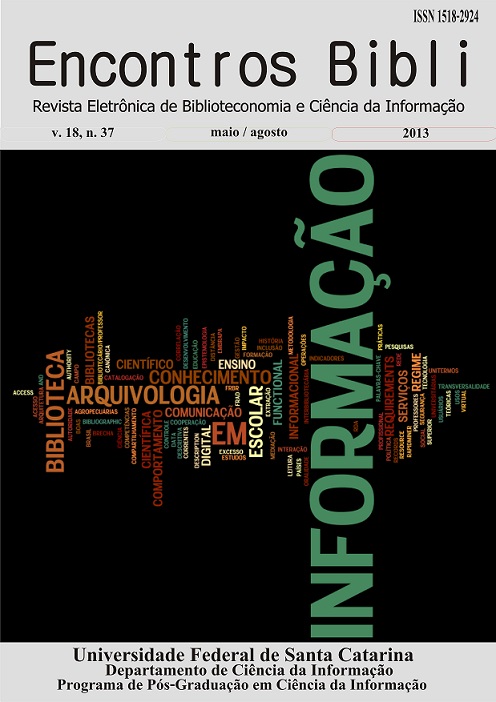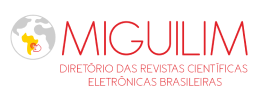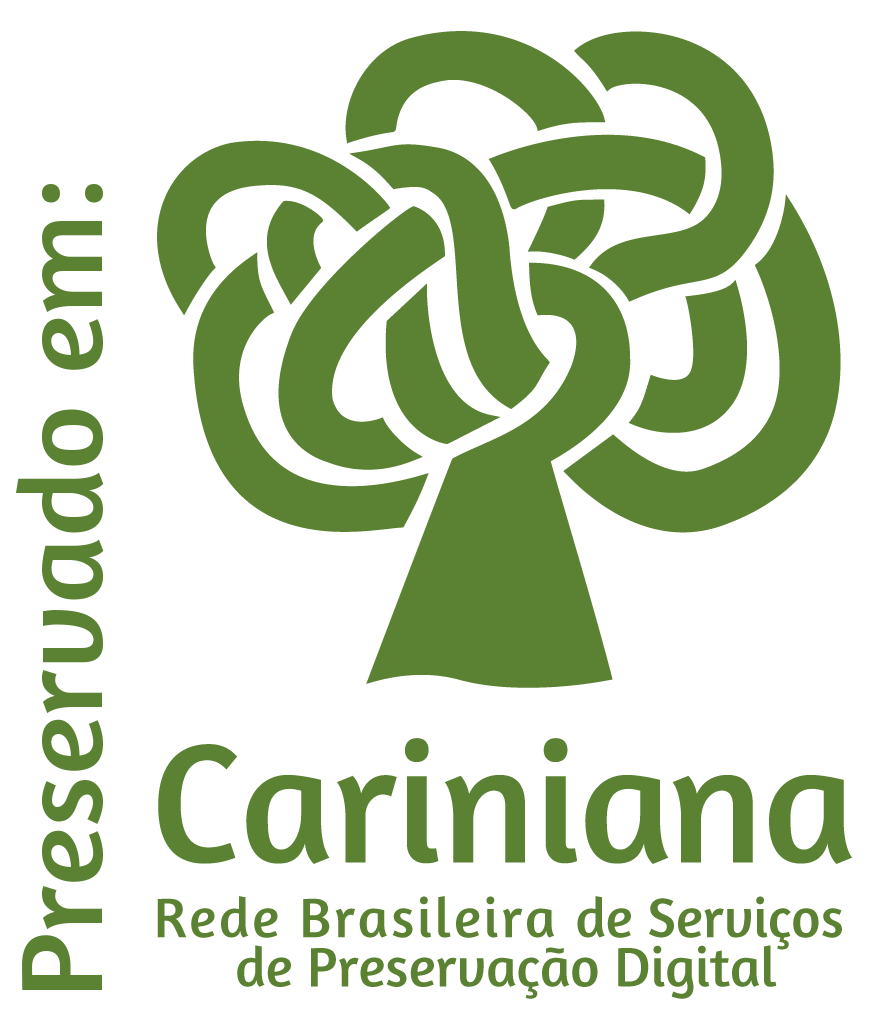Gestão da Informação e do Conhecimento no âmbito das práticas de Segurança da Informação: o fator humano nas organizações
DOI:
https://doi.org/10.5007/1518-2924.2013v18n37p175Palavras-chave:
Segurança da Informação, Gestão da Informação e do Conhecimento, Comportamento InformacionalResumo
O presente artigo pretende levantar, na literatura de Ciência da Informação, informações acerca de como os aspectos humanos interferem nas práticas gerenciais de segurança da informação. Através de uma pesquisa quantitativa pretende-se obter informações sobre os perfis e ações comportamentais dos colaboradores de uma empresa na área da saúde e a inter-relação com falhas de segurança da informação. Na avaliação dos dados verifica-se que o elemento pessoas é uma variável crítica na gestão de segurança informacional nas organizações.
Downloads
Referências
ALLEN, B. L. Toward a user-centered approach to information systems. Los Angeles: Academic Press, 1996, 308p.
ALMEIDA, M.B. Aplicação de Ontologias em Segurança da Informação. Fonte, v.4, n.7, p.75-83, 2007.
ANDALÉCIO, A.L.; SOUZA, R.R. Ciência Cognitiva e Ciência da Informação: Paralelos. Inf. Inf., v.13, n.1, p.72- 80, jan./jul.,2008.
BABBIE, E. Métodos de Pesquisa Survey. Tradução Guilherme Cezarino. Belo Horizonte: UFMG, 1999. 519 p.
BARBOSA, R. R. Inteligência Empresarial: uma avaliação de fontes de informação sobre o ambiente organizacional externo. Disponível em: <http://www.dgz.org.br/dez02/Art_03.htm>. Acesso:10 dezembro 2011
BEAUTEMENT, A.; SASSE, M.A. (2010). The Compliance Budget: The economics of user effort in information security. Computer Fraud & Security, v.2009, n.10, Pages 8-12, 2009.
CHOO, C. W. A organização do conhecimento. 2a. ed. São Paulo: SENAC, 2006. 426p.
COLWILL, C. Human factors in information security: The insider threat & Who can you trust these days? Disponível em: <http://www.infosec.co.uk/files/istr_article_on_risk.pdf>. Acesso: 22 janeiro 2010.
DA VEIGA, A.; ELOFF, J.H.P. A framework and assessment instrument for information security culture. Computer & Security, v.29, p.196-207, 2010.
EVERETT, C. Cover Story: Education, Education, Education. Infosecurity, n.6, v.5, p. 14-18, 2008.
GHERNAOUTI-HÉLIE, S. An inclusive information society needs a global approach of information security. Disponível em: <http://ieeexplore.ieee.org/>. Acesso: 15 janeiro 2009.
HUANG, D. L.; RAU, P. L. P.; SALVENDY, G. Perception of information security. Behaviour & Information Technology, v.29, n.3, p. 221- 232, 2010.
KRAEMERA,S.; CARAYON, P.; CLEM, J. Human and organizational factors in computer and information security: Pathways to Vulnerabilities. Computer & Security, v.28, p. 509-520, 2009.
MALHOTRA, N. K. Pesquisa de Marketing: Uma Orientação Aplicada. Porto Alegre: Bookman, 2012. 720p.
MARCHIONINI, G. Digital Library Research and Development. Encyclopedia of Library and Information Science, v.63, p.611-19, 1998.
MEADOW, C. T. Text information retrieval systems. San Diego: Academic Press, 1992. 302p.
NARITA, T.; KITAMURA, Y. Persuasive Conversational Agent with persuasion tactics. LNCS, v. 6137, p.15-26, 2010.
NIEKERK, J.F.V.; SOLMS, R.V. Information Security Culture: A management perspective. Computer &Security, v.29, n.4, p.476-486, 2010.
PEREIRA, F. C. M. Uso de fontes de informação: um estudo em micro e pequenas empresas de consultoria de Belo Horizonte.155f. Mestrado em Ciência da Informação – Escola de Ciência da Informação, Universidade Federal de Minas Gerais, Belo Horizonte, 2006.
RICHARDSON, R. J. Pesquisa social: métodos e técnicas. 3ª Ed. São Paulo: Atlas, 2007
SVEEN, F. O.; TORRES, J. M.; SARRIEGI, J. M. Blind Information Security Strategy. International Journal of Critical infrastructure Protection, v.2, p.95-109, 2009.
WILSON, T.D. Revisiting user studies and information needs. Journal of Documentation, v. 62, p.680-684, 2006b
WILSON, T.D. On user studies and information needs. Journal of Documentation, v. 62, p.658-670, 2006c.
WORKMANN, M. Wisecrackers: A Theory-Grounded Investigation of Phishing and Pretext Social Engineering Threats to Information Security. Journal of American Society of Information Science and Technology, v.59, n.4, p. 662–674, 2007.
Downloads
Publicado
Como Citar
Edição
Seção
Licença
Copyright (c) 2013 Luciana Emirena Santos Carneiro, Maurício Barcellos Almeida

Este trabalho está licenciado sob uma licença Creative Commons Attribution 4.0 International License.
O autor deve garantir:
- que haja um consenso completo de todos os coautores em aprovar a versão final do documento e sua submissão para publicação.
- que seu trabalho é original, e se o trabalho e/ou palavras de outras pessoas foram utilizados, estas foram devidamente reconhecidas.
Plágio em todas as suas formas constituem um comportamento antiético de publicação e é inaceitável. Encontros Bibli reserva-se o direito de usar software ou quaisquer outros métodos de detecção de plágio.
Todas as submissões recebidas para avaliação na revista Encontros Bibli: revista eletrônica de biblioteconomia e ciência da informação passam por identificação de plágio e autoplágio. Plágios identificados em manuscritos durante o processo de avaliação acarretarão no arquivamento da submissão. No caso de identificação de plágio em um manuscrito publicado na revista, o Editor Chefe conduzirá uma investigação preliminar e, caso necessário, fará a retratação.
Esta revista, seguindo as recomendações do movimento de Acesso Aberto, proporciona seu conteúdo em Full Open Access. Assim os autores conservam todos seus direitos permitindo que a Encontros Bibli possa publicar seus artigos e disponibilizar pra toda a comunidade.
Os conteúdos de Encontros Bibli estão licenciados sob uma Licença Creative Commons 4.0 by.

Qualquer usuário tem direito de:
- Compartilhar — copiar, baixar, imprimir ou redistribuir o material em qualquer suporte ou formato
- Adaptar — remixar, transformar, e criar a partir do material para qualquer fim, mesmo que comercial.
De acordo com os seguintes termos:
- Atribuição — Você deve dar o crédito apropriado, prover um link para a licença e indicar se mudanças foram feitas. Você deve fazê-lo em qualquer circunstância razoável, mas de maneira alguma que sugira ao licenciante a apoiar você ou o seu uso.
- Sem restrições adicionais — Você não pode aplicar termos jurídicos ou medidas de caráter tecnológico que restrinjam legalmente outros de fazerem algo que a licença permita.

























